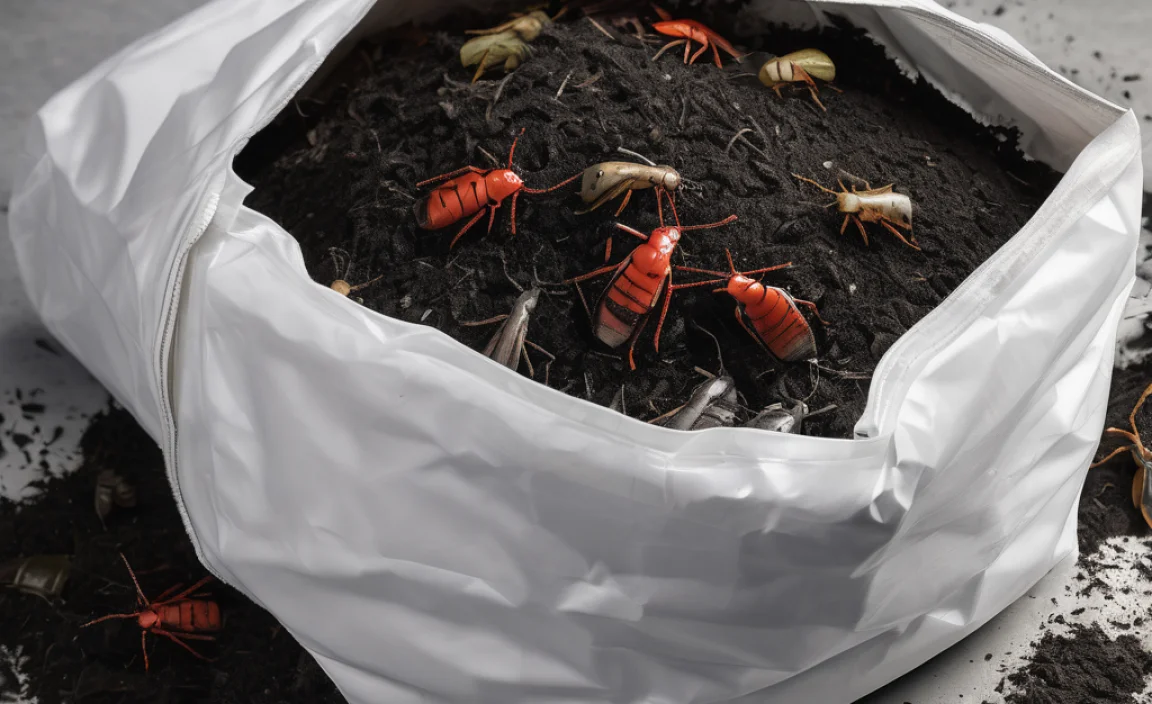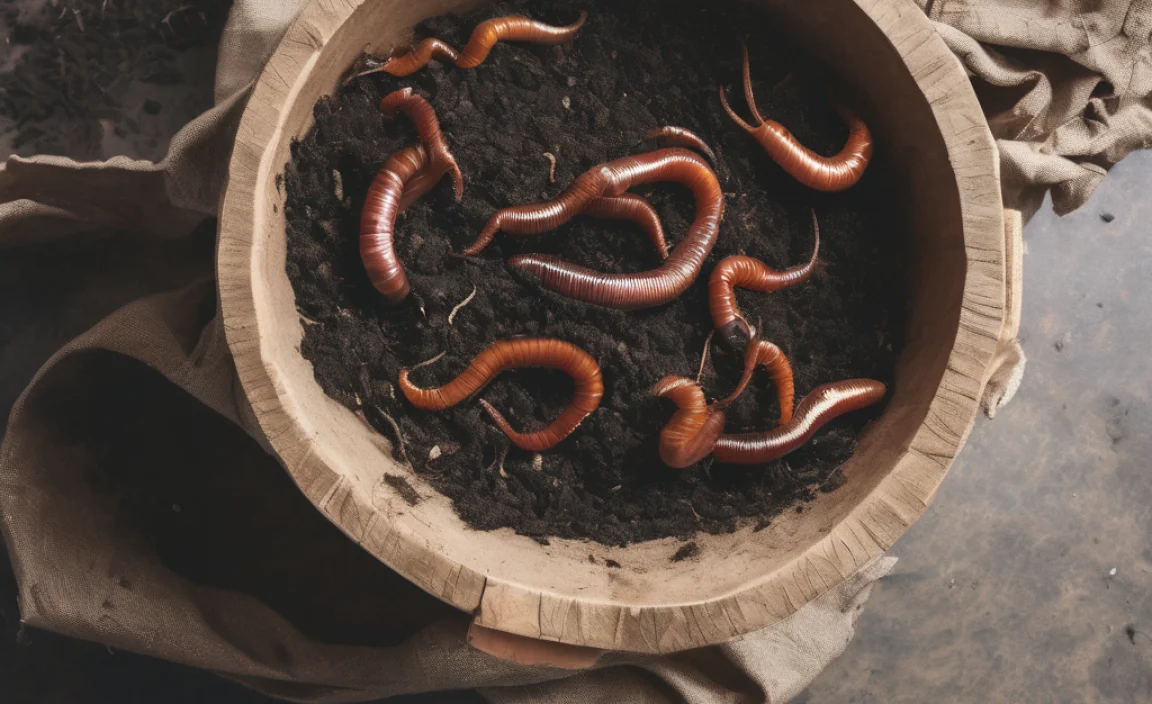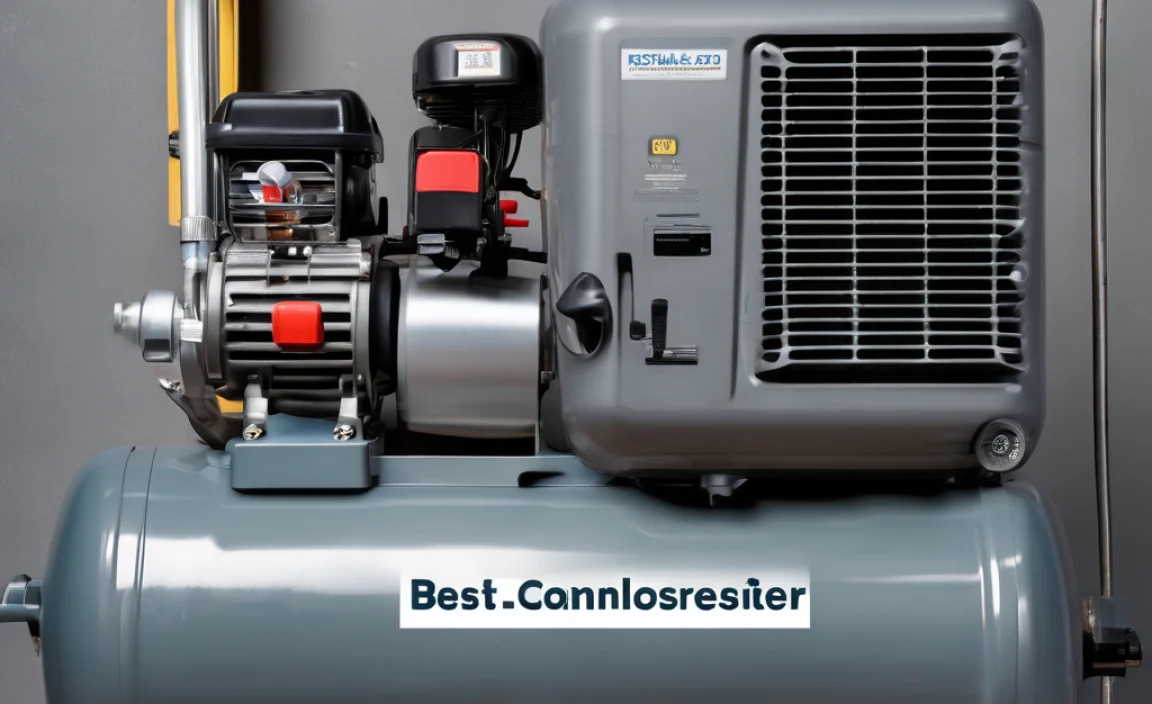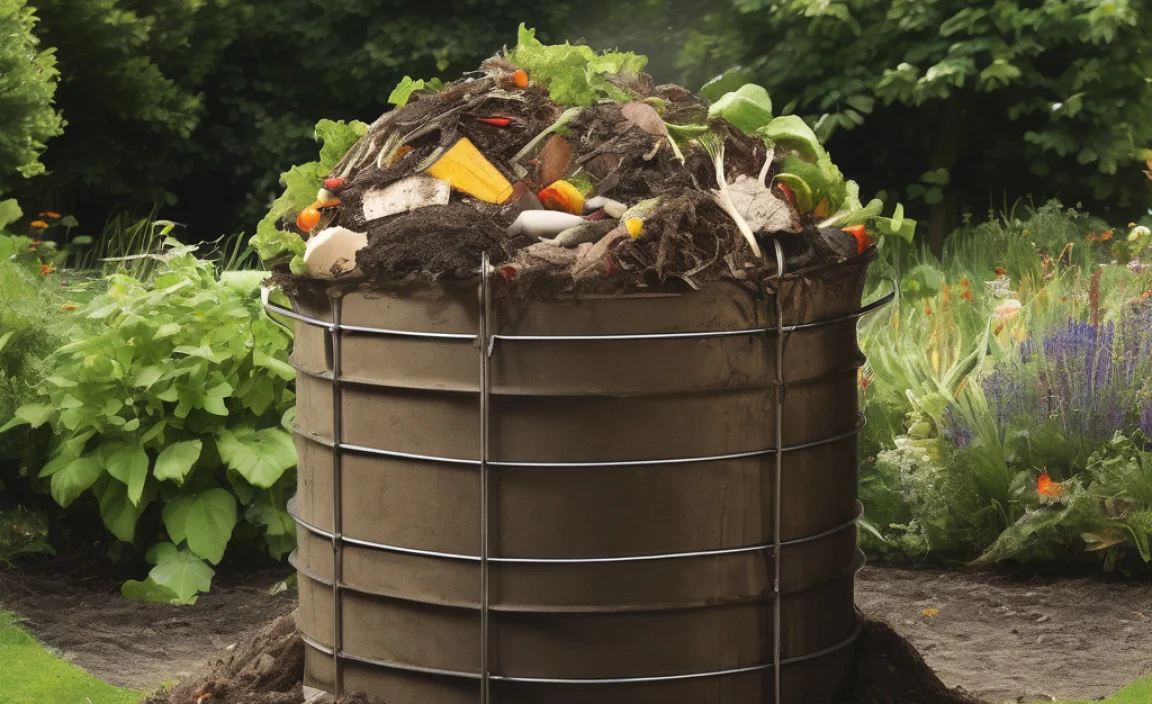Got bugs in your compost bags? Don’t sweat it! It happens to the best of us when we’re trying to do good for our gardens and the planet. Seeing creepy crawlies in your compost might seem a little unsettling, but it’s often a sign that things are working! We’ll walk through how to handle these little visitors so your compost keeps doing its magic without any unwanted guests causing a fuss.
Compost Bags Bugs: Your Friendly Guide to Bug Control

Hey there! Troy D Harn here, your go-to guy for making home, garden, and DIY projects a breeze. Today, we’re tackling a topic that might make you do a double-take: bugs in your compost bags. If you’ve peeked into your compost bin or bag and seen more than just decaying leaves and kitchen scraps, you might be wondering if that’s normal. The short answer? Yes, it often is! But also, sometimes you need to step in and manage the situation. Think of me as that neighbor who’s always happy to share a tip or two over the fence. We’ll break down what bugs are good, what bugs might be a problem, and most importantly, how to keep your compost bag a happy, healthy home for decomposition, not a bug hotel for the unwelcome kind.
Composting is a fantastic way to reduce waste and create nutrient-rich soil for your garden. But let’s be honest, the thought of bugs can be a turn-off for some. We’re going to demystify the situation, focusing on practical, easy-to-follow advice that’ll have you composting like a pro. No fancy jargon, just straightforward solutions. Ready to get your compost in tip-top shape while keeping the bug population in check? Let’s dive in!
Why Do Bugs Show Up in Compost Bags?
First off, let’s understand why these little critters are attracted to your compost bag in the first place. Your compost bag is essentially a buffet for many types of insects and other invertebrates. They are drawn to the organic matter that’s breaking down, seeking out moisture, nutrients, and a place to live. It’s their job, in a way, to help with the decomposition process! Many of the bugs you find are actually beneficial decomposers, playing a crucial role in turning your waste into valuable compost.
Think of it this way: a healthy compost pile is a living ecosystem. Just like a forest floor or a garden bed, it hosts a variety of life. This decomposition crew helps break down your food scraps and yard waste faster. So, seeing a few ants, beetles, or even earthworms is a good sign that your compost is active and healthy.
The Good Guys: Beneficial Compost Bugs
It’s important to know that not all bugs in your compost are pests. Many are actually your compost’s best friends! They help aerate the pile, break down materials, and speed up the composting process. Here are some of the common, helpful inhabitants you want to encourage:
- Earthworms: These are the superstars of composting! They munch on organic matter, leaving behind nutrient-rich castings. They are essential for “vermicomposting” (worm composting) and also thrive in traditional compost piles.
- Springtails: These tiny, jumping insects are often one of the first to appear. They love damp environments and are excellent at breaking down tougher materials like fungi and molds. You might see them as little white specs that quickly disappear when disturbed.
- Mites: Not all mites are bad! Many compost mites feed on decaying organic matter and help break it down. They are usually microscopic or very small and red or brown in color.
- Soldier Fly Larvae: These fat, segmented larvae might look a bit intimidating, but they are composting powerhouses! They can eat through food scraps quickly and often help reduce odors. Their presence is usually a sign of a very active, warm compost pile.
- Ground Beetles: These are predatory insects that can help control other pest populations that might be attracted to your decaying waste.
These guys are your allies. They help turn kitchen scraps and yard waste into that rich, dark compost you’re dreaming of. So, if you see a few of these around, consider it a job well done by nature!
The Not-So-Good Guys: Compost Bugs to Watch Out For
While many bugs are beneficial, a few can signal an imbalance in your compost bag or become a nuisance if their population explodes. These are the ones we’ll focus on managing. Usually, their presence in large numbers indicates an issue with the compost’s moisture, temperature, or carbon-to-nitrogen ratio.
- Ants: While some ants might be hunting other pests, a large ant colony can be a problem. They can dry out your compost pile, and their nests can disrupt the composting process. Ants are typically a sign that your compost is too dry or not actively managed.
- Fruit Flies: These tiny flies are attracted to exposed fruit and vegetable scraps. They are more annoying than harmful to the composting process itself, but they can be a real nuisance around your home or compost area.
- Cockroaches: This is almost always a sign of a problem. Cockroaches are attracted to decaying food and can indicate that your compost is too wet, too smelly, or contains too much material that’s actively attracting them, like meat or dairy (which you should avoid composting anyway).
- Slugs and Snails: While often found in gardens, large numbers in a compost bag might signal an overly wet environment and can be a bit slimy to deal with. They can slow down decomposition if the pile isn’t hot enough.
A quick note on what NOT to compost: To help prevent unwanted pests like cockroaches and rodents, avoid adding meat, dairy products, oily foods, and pet waste (dog/cat). These items can attract larger pests and create unpleasant odors.
Identifying the Problem: Why Are Bugs Taking Over?
The key to pest control in compost bags is understanding what’s attracting them. Usually, an infestation of “bad bugs” points to an imbalance in your compost bag’s conditions. Let’s look at the most common culprits:
1. Moisture Levels: Too Wet or Too Dry?
Moisture is critical. Your compost needs to be damp like a wrung-out sponge, not soaking wet or bone dry.
- Too Wet: This creates anaerobic (low-oxygen) conditions which lead to foul odors and can attract pests like slugs, snails, and sometimes even maggots (non-beneficial types). It also makes things mushy and attracts flies.
- Too Dry: If your compost is too dry, decomposition slows down, and it can become an attractive, dry habitat for ants looking for moisture.
2. Aeration: Is Air Flowing?
Compost needs oxygen to break down efficiently. If your compost bag is compacted or hasn’t been turned, it can become anaerobic, leading to smells and attracting the wrong kinds of bugs.
3. Compost Heap Composition: The Green and Brown Balance
Compost relies on a mix of “greens” (nitrogen-rich materials like kitchen scraps and grass clippings) and “browns” (carbon-rich materials like dry leaves, shredded cardboard, and twigs). A lack of browns or too many greens can lead to a nitrogen-rich, wet, and smelly pile that attracts flies and other undesirable visitors.
A good rule of thumb is to aim for roughly 2-3 parts browns to 1 part greens. This balance:
- Provides the right carbon-to-nitrogen ratio for microorganisms.
- Helps absorb excess moisture.
- Creates better airflow.
- Reduces odors.
For more on balancing your compost, the Oregon State University Extension Service has some great resources on composting basics.
4. Exposed Food Scraps
One of the biggest attractors of fruit flies and other pests is exposed food waste, especially fruit and vegetable scraps. If these aren’t buried properly within the compost material, they become an easy buffet.
5. Temperature
A hot compost pile (around 130-160°F or 54-71°C) is excellent for fast decomposition and killing weed seeds and pathogens. If your compost isn’t heating up, you might have issues with moisture, aeration, or the brown/green balance, which can allow pests to thrive.
Essential Pest Control Strategies for Your Compost Bag
Now that we know what’s causing the bug issues, let’s get to the solutions! These are simple, practical steps you can take to manage pests without resorting to harsh chemicals.
Step-by-Step Guide to Bug-Free Composting
Step 1: Check and Adjust Moisture Levels
Action: Feel your compost. It should be moist like a wrung-out sponge.
- If too wet: Add more “browns” (dry leaves, shredded paper, sawdust). These will absorb excess moisture and improve aeration. You may need to gently turn or mix the pile to help it dry out. You can also leave the compost bag open to the air for a while, especially if it’s raining, or if you have a lid, ensure it’s not trapping all the moisture in.
- If too dry: Add water. You can use a hose or a watering can. Mix the water in thoroughly to ensure it distributes everywhere. You may need to add more “greens” to reintroduce moisture and nitrogen.
Step 2: Improve Aeration and Turn Your Compost
Action: Regularly turn or mix your compost bag.
- How often: Aim to turn your compost every 1-2 weeks. This introduces oxygen, which beneficial microbes need to thrive and helps prevent anaerobic pockets that smell bad and attract pests.
- Tools: A compost aerator tool, a garden fork, or a spade can be used. For compost bags, some systems are designed for easy tumbling or have built-in aeration. If it’s a simple fabric bag, you might need to use a fork to lift and turn the contents.
Step 3: Maintain the Green and Brown Balance
Action: Add materials in the right ratio.
- When adding kitchen scraps (greens): Always bury them a few inches deep within the compost material. Layering them with “browns” as you add them is a great strategy to prevent flies and foraging by other pests.
- When adding dry yard waste (browns): Ensure you have enough readily available. Shredding larger brown materials (like cardboard) can speed up their decomposition.
Step 4: Cover Exposed Food Scraps
Action: Don’t leave food waste sitting on top.
- Every time you add kitchen scraps, cover them with a layer of brown material (leaves, shredded paper/cardboard). This is your primary defense against fruit flies and other scavengers.
- If fruit flies are already a problem, you can temporarily cover the top layer with a thicker layer of browns or even a piece of old carpet or burlap to block them.
Step 5: Manage Ant Infestations
Action: Address the cause.
- Ants usually appear when the compost is too dry. Follow Step 1 to increase moisture.
- If you have a persistent ant problem, try adding a layer of diatomaceous earth around the base of the compost bin or lightly around the edges of a bag, being careful not to inhale the dust. It’s a natural pesticide that works physically by destroying the exoskeletons of small insects. According to the EPA, it’s considered low in toxicity.
Step 6: Deal with Cockroaches (Rarely)
Action: This is a serious sign and needs immediate attention.
- First, stop adding “greens” for a bit and focus on adding a lot of “browns.”
- Ensure the compost is getting enough air by turning it frequently.
- Check if you’ve accidentally added anything you shouldn’t have (meat, dairy, oils). Remove these items if possible.
- If the problem persists, you might need to empty the bin, sift through materials, and start fresh, ensuring proper balance and aeration. For severe issues, consider a natural pest control method, but always aim to fix the underlying issue first.
Here’s a quick look at some tools that can help you keep your compost bag in good shape:
| Tool | Purpose | Ease of Use |
|---|---|---|
| Compost Aerator Tool | For mixing and aerating compost without strenuous turning. | Very Easy |
| Garden Fork/Spade | For turning larger piles or breaking up compacted areas. | Moderate |
| Watering Can/Hose with Sprayer | for adding moisture evenly. | Easy |
| Shredder (optional) | To break down brown materials for faster decomposition. | Moderate |
| Gloves | To keep your hands clean and comfortable. | Essential |
Choosing the Right Compost Bag for Pest Prevention
Sometimes, the compost bag itself can contribute to pest problems. If you’re using a simple fabric bag or an open bin, pests have easier access. Consider these options:
- Enclosed Compost Bins: These are great for keeping pests out. They have lids and are made of solid plastic or wood, preventing easy access for larger insects and animals.
- Tumbler Composters: These enclosed barrels rotate, making turning easy and keeping pests out.
- Worm Bins (for specific composting): While these are designed for worms, they are usually well-sealed and can prevent unwanted pests from entering.
- Breathable Compost Bags: Some fabric bags are designed to allow good airflow, which helps prevent anaerobic conditions. However, they might still allow smaller insects to enter and exit more freely.
If you’re using a basic compost bag, focusing on proper management (as outlined above) is your best bet. Always ensure your compost bag has good drainage to prevent waterlogging.
Natural Pest Control for Compost
When you need a little extra help, there are natural ways to deal with persistent compost bugs:
- Beneficial Insects: Ladybugs and predatory beetles are natural predators of aphids and other small pests. Encouraging them in your garden can indirectly help your compost.
- Diatomaceous Earth (Food Grade): As mentioned, this can be used around the base of bins or lightly sprinkled on top (avoid inhaling). It’s made from fossilized algae and acts as a desiccant for insects with exoskeletons.
- Vinegar Traps: For fruit flies, a shallow dish with a bit of apple cider vinegar and a drop of dish soap can attract and drown them. Place these near, but not inside, your compost bag if the infestation is severe.
Safety First! Always use food-grade diatomaceous earth and follow its instructions carefully. For any pest control, natural or otherwise, ensure it won’t harm beneficial organisms involved in composting.
Compost Bag Bugs: Quick Summary Table
Here’s a quick reference for identifying common compost bag bugs and their usual causes/solutions:
| Bug/Pest | Common Cause | Primary Solution | Prevention Tip |
|---|---|---|---|
| Ants | Compost too dry | Add moisture, mix well | Maintain consistent moisture |
| Fruit Flies | Exposed food scraps, particularly fruits/veggies | Bury food scraps, add browns | Always cover fresh scraps |
| Slugs & Snails | Compost too wet, lack of aeration | Add browns, turn compost | Maintain balanced moisture & aeration |
| Cockroaches | Too wet, poor aeration, added prohibited items (meat/dairy) | Fix moisture/aeration, remove prohibited items, turn often | Never add meat/dairy/oils, maintain balance |
| Soldier Fly Larvae | Warm, active compost pile | None needed! They are beneficial. | Keep an active compost pile. |
Troubleshooting Common Compost Bag Problems & Bug Prevention
Sometimes, even with the best

I am passionate about home engineering. I specialize in designing, installing, and maintaining heating, ventilation, and air conditioning systems. My goal is to help people stay comfortable in their homes all year long.




